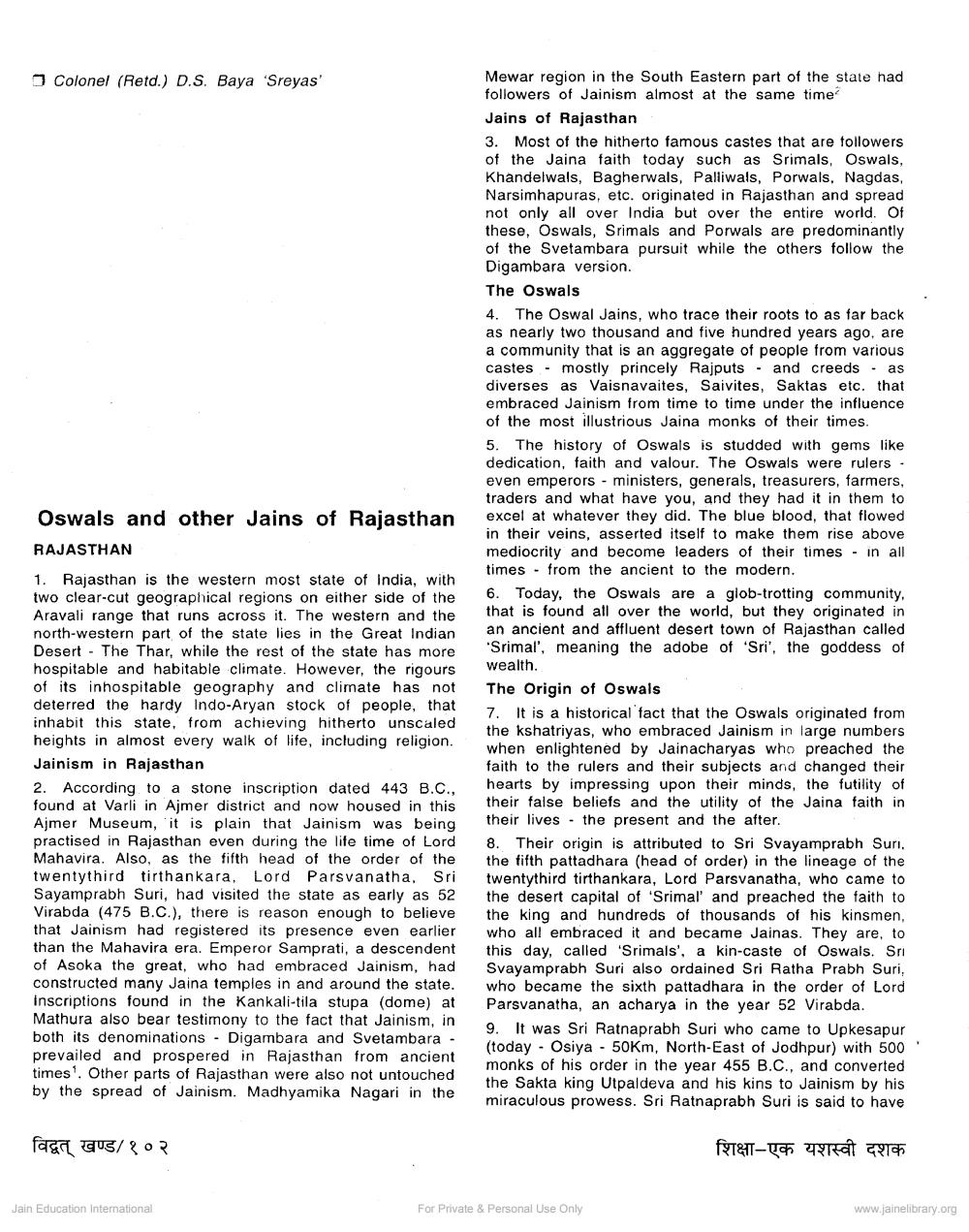Book Title: Oswals and Other Jains of Rajasthan Author(s): D S Baya Publisher: Z_Jain_Vidyalay_Granth_012030.pdf View full book textPage 1
________________ Colonel (Retd.) D.S. Baya 'Sreyas' Oswals and other Jains of Rajasthan RAJASTHAN 1. Rajasthan is the western most state of India, with two clear-cut geographical regions on either side of the Aravali range that runs across it. The western and the north-western part of the state lies in the Great Indian Desert - The Thar, while the rest of the state has more hospitable and habitable climate. However, the rigours of its inhospitable geography and climate has not deterred the hardy Indo-Aryan stock of people, that inhabit this state, from achieving hitherto unscaled heights in almost every walk of life, including religion. Jainism in Rajasthan 2. According to a stone inscription dated 443 B.C., found at Varli in Ajmer district and now housed in this Ajmer Museum, it is plain that Jainism was being practised in Rajasthan even during the life time of Lord Mahavira. Also, as the fifth head of the order of the twentythird tirthankara, Lord Parsvanatha, Sri Sayamprabh Suri, had visited the state as early as 52 Virabda (475 B.C.), there is reason enough to believe that Jainism had registered its presence even earlier than the Mahavira era. Emperor Samprati, a descendent of Asoka the great, who had embraced Jainism, had constructed many Jaina temples in and around the state. Inscriptions found in the Kankali-tila stupa (dome) at Mathura also bear testimony to the fact that Jainism, in both its denominations - Digambara and Svetambara - prevailed and prospered in Rajasthan from ancient times. Other parts of Rajasthan were also not untouched by the spread of Jainism. Madhyamika Nagari in the Mewar region in the South Eastern part of the state had followers of Jainism almost at the same time Jains of Rajasthan 3. Most of the hitherto famous castes that are followers of the Jaina faith today such as Srimals, Oswals, Khandelwals, Bagherwals, Palliwals, Porwals, Nagdas, Narsimhapuras, etc. originated in Rajasthan and spread not only all over India but over the entire world. Of these, Oswals, Srimals and Porwals are predominantly of the Svetambara pursuit while the others follow the Digambara version. The Oswals 4. The Oswal Jains, who trace their roots to as far back as nearly two thousand and five hundred years ago, are a community that is an aggregate of people from various castes - mostly princely Rajputs and creeds . as diverses as Vaisnavaites, Saivites, Saktas etc. that embraced Jainism from time to time under the influence of the most illustrious Jaina monks of their times. 5. The history of Oswals is studded with gems like dedication, faith and valour. The Oswals were rulers. even emperors - ministers, generals, treasurers, farmers, traders and what have you, and they had it in them to excel at whatever they did. The blue blood, that flowed in their veins, asserted itself to make them rise above mediocrity and become leaders of their times - in all times - from the ancient to the modern. 6. Today, the Oswals are a glob-trotting community, that is found all over the world, but they originated in an ancient and affluent desert town of Rajasthan called 'Srimal', meaning the adobe of 'Sri', the goddess of wealth. The Origin of Oswals 7. It is a historical fact that the Oswals originated from the kshatriyas, who embraced Jainism in large numbers when enlightened by Jainacharyas who preached the faith to the rulers and their subjects and changed their hearts by impressing upon their minds, the futility of their false beliefs and the utility of the Jaina faith in their lives - the present and the after. 8. Their origin is attributed to Sri Svayamprabh Suri. the fifth pattadhara (head of order) in the lineage of the twentythird tirthankara, Lord Parsvanatha, who came to the desert capital of 'Srimal and preached the faith to the king and hundreds of thousands of his kinsmen, who all embraced it and became Jainas. They are, to this day, called 'Srimals', a kin-caste of Oswals. Sri Svayamprabh Suri also ordained Sri Ratha Prabh Suri, who became the sixth pattadhara in the order of Lord Parsvanatha, an acharya in the year 52 Virabda 9. It was Sri Ratnaprabh Suri who came to Upkesapur (today - Osiya - 50Km, North-East of Jodhpur) with 500 monks of his order in the year 455 B.C., and converted the Sakta king Utpaldeva and his kins to Jainism by his miraculous prowess. Sri Ratnaprabh Suri is said to have विद्वत् खण्ड/१०२ शिक्षा-एक यशस्वी दशक Jain Education International For Private & Personal Use Only www.jainelibrary.orgPage Navigation
1 2 3
